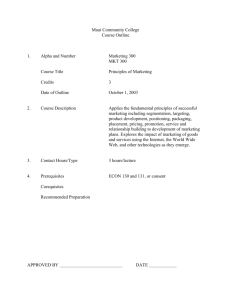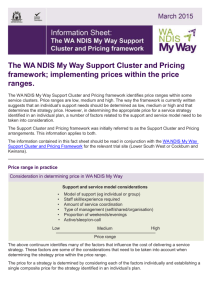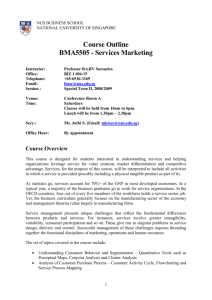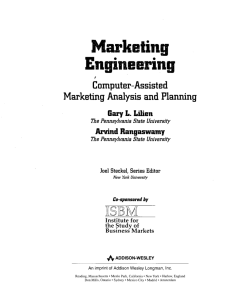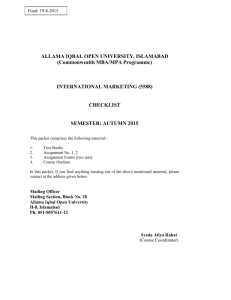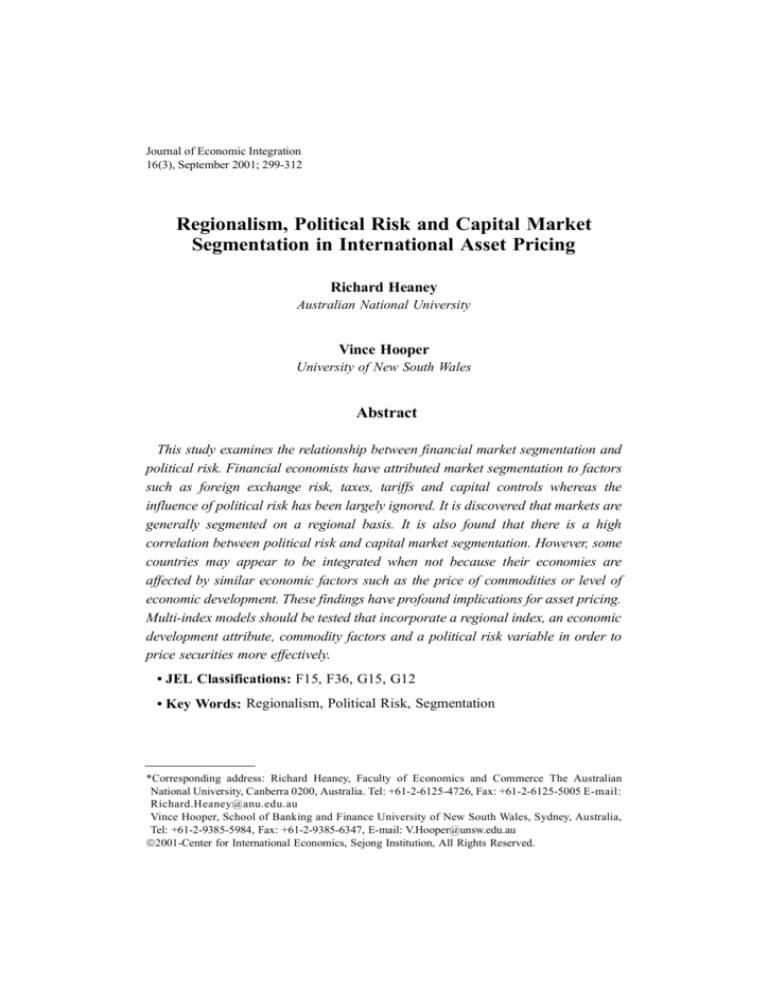
Journal of Economic Integration
16(3), September 2001; 299-312
Regionalism, Political Risk and Capital Market
Segmentation in International Asset Pricing
Richard Heaney
Australian National University
Vince Hooper
University of New South Wales
Abstract
This study examines the relationship between financial market segmentation and
political risk. Financial economists have attributed market segmentation to factors
such as foreign exchange risk, taxes, tariffs and capital controls whereas the
influence of political risk has been largely ignored. It is discovered that markets are
generally segmented on a regional basis. It is also found that there is a high
correlation between political risk and capital market segmentation. However, some
countries may appear to be integrated when not because their economies are
affected by similar economic factors such as the price of commodities or level of
economic development. These findings have profound implications for asset pricing.
Multi-index models should be tested that incorporate a regional index, an economic
development attribute, commodity factors and a political risk variable in order to
price securities more effectively.
• JEL Classifications: F15, F36, G15, G12
• Key Words: Regionalism, Political Risk, Segmentation
*Corresponding address: Richard Heaney, Faculty of Economics and Commerce The Australian
National University, Canberra 0200, Australia. Tel: +61-2-6125-4726, Fax: +61-2-6125-5005 E-mail:
Richard.Heaney@anu.edu.au
Vince Hooper, School of Banking and Finance University of New South Wales, Sydney, Australia,
Tel: +61-2-9385-5984, Fax: +61-2-9385-6347, E-mail: V.Hooper@unsw.edu.au
2001-Center for International Economics, Sejong Institution, All Rights Reserved.
300
Richard Heaney and Vince Hooper
I. Introduction
This paper has two main purposes. First, a primary aim of this paper is to
investigate the degree of market segmentation of financial markets by analysing
the stock market returns of both developed and developing markets using cluster
analysis. Cluster analysis is used because it is able to group stock market returns
on the basis of similarity. Stock markets that have related return patterns have been
those identified by previous studies to be more integrated. We see the emergence
of a clustering of stock markets that is broadly on a regional basis. A further aim
of this paper is to investigate the connection between political risk and market
integration. The outcome of the research has profound implications for asset
pricing models.
In a rarefied world of perfection in which markets are continually in
equilibrium, access to information is costless and investors are purely rational then
all of the worlds markets would be truly integrated. Under such conditions, capital
would be free to traverse international frontiers and asset prices would conform to
an internationalised version of the capital asset pricing model [Stulz (1981)]. All
equilibriating price adjustments would be assumed to be instantaneous, either because changes are timeless or because all changes have been perfectly foreseen.
However we do not live under such a quixotic paradigm. Frictions exist, which
within an economic sense are market impurities that affect the way in which the
laws of supply and demand interact. Market impurities prevent a general
equilibrium from holding but create a series of partial equilibria for individual
nations capital markets. The consequences of a disregard for market imperfections
creating disequilibrium situations are such that justifiable doubt can be cast upon
the theoretical and empirical application of the equilibrium-based tenets of the
capital asset pricing model (CAPM). Within financial economics there is
widespread ignorance of the impact of government policies as a major driver of
market irregularities. It can be argued that all investment decisions are made
within an arena of disequilibrium caused by the uncertainty associated with future
government policy and the state of the nation [Kaldor (1972)]. The contribution of
this paper to the literature is the discovery that financial market segmentation may
indeed be due to political risk, that asset pricing models need to capture more fully
government policies, incorporate the effects of regionalism and stage of economic
development. It is also discovered that there is a spatial dimension associated with
market segmentation.
Regionalism, Political Risk and Capital Market Segmentation in......
301
Within a domestic and international context, the capital asset pricing model has
been found to be a poor prediction model for security’s prices. While the
theoretical derivation of the CAPM is solid, its impact within a real world of
market imperfections is limited. Fama and French (1992) have found a weak
association between beta and average returns. Further they find a statistically
significant relationship between firm size, the ratio of market value to book value
of assets and mean returns. Further, Roll (1977) has stressed that the market proxy
may not be mean-variance efficient. Other frameworks have been developed to
value securities, notably the international arbitrage pricing theory (IAPT) has
emerged as a response to the inadequacies of the international asset pricing model
(IAPM) [Solnik (1983)]. However, the IAPT remains very much in its infancy and
empirical testing remains sketchy. However, a positive step in the international
pricing of securities is the derivation of an IAPT that incorporates the effects of
market imperfections [Fang (1992)]. Arbitrage pricing theory [Ross (1976)] is
founded upon the assertion that a security’s return is composed of an expected and
an unexpected part1. A major critique of the arbitrage theory has been its empirical
confirmation and the identification of factors driving returns of securities on an a
priori and ex post basis2. Multi-index models have thus emerged as an extension
to single index frameworks3 and an attempt to capture the influences of two or
more factors upon a securities return 4 which tend to be macroeconomic in nature.
The results of this study suggest a grouping of stock market returns on a regional
basis. This regional ordering of stock market returns corresponds with the ranking
of political risk for each country concerned. It is reasonable to assume a regional
impact in asset pricing because nations are more tightly bound by regional trade
agreements, which inturn is driven by similar economic, social, political and
cultural patterns. The concept of regionalism has emerged as a powerful force in
geopolitical dynamics, trade theory and international finance. Game theoretical
frameworks suggest that it is optimal for nation states to negotiate treaties on a
regional basis rather than multilaterally [Cochinard (1995)]. Regionalism is not
1
The expected return is common to all assets. The unexpected return contains a systematic and an
unsystematic component. The systematic risk depends upon the sensitivities to a number of factors. A
firms systematic risk is uncorrelated with its unsystematic risk factors.
2
Principal component analysis with varimax rotation (factor analysis) has been used to test the APT
model. A potential weakness of factor analysis is the interpretation of extracted factors, as well as the
method of extraction.
3
The Capital Asset Pricing Model (CAPM) is essentially a simple index model.
4
The work on multi-index models emanated from the work of King (1966).
302
Richard Heaney and Vince Hooper
only driven by geographic proximity of countries but similar cultural backgrounds
and a complex interwoven mesh of trade, portfolio and foreign direct investment
flows. The growing regionalism in the world today is viewed as a response to a
cumbersome World Trade Organisation as an institution in the multilateral trading
system and the repositioning of the super powers to a more polycentric stature.
Regionalism is the fragmentation of over ambitious globalisation. As a result there
is a high degree of economic interdependency nurtured between entities within
regions which appears to be increasing over time. This leads to the idea that firms
within them are affected often by similar exogenous shocks. Often idiosyncratic
jolts tend to deepen and widen regional integration. This commonality and sense
of belonging that prevails within regions may be reflected in related stock price
movements. Financial economists have largely ignored the idea that stock markets
may be driven more by regional factors than by global effects. Studies have tended
to focus upon testing whether the international capital asset pricing model holds
despite some of the criticisms levelled at the limits to its empirical verification.
Multi-index models have not used a regional index. Some trading agreements in
Asia such as the Association of South East Asian Nations (ASEAN) provide
ample evidence of a strong regional relationship existing between nations stock
exchanges relative to the world market portfolio5. This indicates that asset pricing
frameworks should perhaps include a regional pricing index.
Capital markets are segmented due to a variety of factors such as exchange rate
risk, different tax systems, capital controls, limits on foreign ownership and
political risk. There are strong grounds to suggest that markets are neither
completely segmented nor fully integrated as polarised extremes but exhibit
characteristics of both [Choi and Rajan (1997)], and, display time-varying comovement with the world market portfolio [Bekaert and Harvey (1995)]. Market
segmentation is brought about by a number of attributes which inhibit the
theoretical CAPM from operating in a real world context [Jorion and Schwartz
(1986), Hietala (1989), Gultekin, Gultekin and Penati (1989), Campbell and
Hamoa (1992), Mittoo (1992), and Errunza, Losq and Padmanabhan, (1992)].
In particular, this study focuses on the effect that political risk has upon market
segmentation because it is ultimately government policies that influence inter5
Heaney and Hooper (1999) find evidence of a strong regional influence upon stock market returns in
Association of South East Asian Nations (ASEAN) countries relative to Asia Pacific Economic Cooperation (APEC) countries.
Regionalism, Political Risk and Capital Market Segmentation in......
303
national capital flux. This line of enquiry has been ignored by financial economists
due to the lack of quantification of political risk 6. Traditional approaches to assessing
political risk in economic decision-making have revolved around a case study
approach. However, some information providers have created proxies for political
uncertainty in the form of indices. A well acknowledged technique for measuring
political risk is the Coplin and OLeary (1985) method. Political Risk Services (PRS)
Inc. provides index data for the purposes of this study.
Political risk is the uncertainty associated with changes in government policy
upon the cash flow patterns accruing to firms and investors. Political risk is best
described as the probability of an event occurring over a given time period and is
usually associated with major changes in government policies precipitated by
dramatic episodes such as war, insurrection or political violence [Jodice (1985)].
Political Risk Services (PRS Inc.) captures political risk according to the attributes
in Table 4. The convention is the higher the index, the lower the political risk. The
rating ranges between 0 and 100.
II. Methodology
The time period covered in this study is from 1st Jan 1985 until 31st December
1997 with the time interval being monthly. The stock market return data is sourced
from the International Finance Corporation and Morgan Stanley for the same
period. The data is monthly price relatives (natural logarithms) which includes a
dividend adjustment.
This paper utilises cluster analysis to determine whether national stock markets
are segmented on a regional basis. The advantage of using cluster analysis over
other regression techniques is that it is a classification technique. In this study an
attempt is made to group emerging stock markets by region. Traditional
classification techniques involve assigning new observations to an established
group whereas cluster analysis involves searching for “natural” groupings
amongst objects and is thus a more inductive approach. Rather than regressing
national stock market returns against a regional index, like the deductive approach
adopted by Heaney and Hooper (1999), cluster analysis partitions cases into
clusters of similar objects, i.e. similar behaviour in national stock market returns.
6
Some authors have focussed upon the impact of government policies as a major creator of market
imperfections within a multinational framework, e.g. Thomas Brewer (1992).
304
Richard Heaney and Vince Hooper
Cluster analysis therefore has the advantage over regression analysis in the sense
that regional and global stock market indices do not need to be constructed. One
may argue that correlation could also be used to measure the degree of
segmentation/correlation of a market. However, a key advantage to using cluster
analysis is that it considers all returns simultaneously instead of pair by pair, as
correlation is only able to do. We are thus able to develop a more comprehensive
measure of stock market segmentation/integration in multi-dimensional space. In
addition, cluster analysis enables us to group stock markets on the basis of similar
volatility patterns unlike correlation analysis.
There are different methods for computing similarity measures between objects.
A fundamental method is the shortest Euclidean distance method between two p
dimensional observations7. Cluster analysis is thus used to assign stock market
returns, into relatively homogenous groups, i.e. regions. By the careful construction of a theoretical foundation, cluster analysis is used to objectively group the
entities or countries using a hierarchical agglomeration algorithm. Aldenderfer
and Blashfield (1984) argue that by using cluster analysis, a form of naïve
empiricism is prevented. Its advantage also lies in the fact that it overcomes the
problem of constructing a regional index because the cluster analysis is run with
the returns of each stock market itself.
The cluster analysis method uses as an input the raw return data for both
developed and emerging stock markets, and sequentially merges the most similar
cases. The mergers of clusters are represented visually via a tree diagram called a
dendogram [Figure 1]. This represents a hierarchical organisation of the relations
between the data points. Although there are a number of variants of cluster
analysis, the average linkage method proposed by Sokal and Michener (1958) was
used because it computes the average of country returns, and joins the country to
a cluster depending on this arithmetic average linkage. Its advantage lies in the fact
that averaging returns across time compensates for the effects of the stochastic
movement of emerging equity market return series.
Monthly stock market returns for thirty four countries are subjected to cluster
analysis. The technique avoids making assumptions about data commonly
associated with the time-series techniques of the financial economist. Cluster
analysis also avoids the critiques associated with deduction and is an inductive
7
For a discussion of clustering techniques, see Johnson and Wichern (1998).
Initially there are as many clusters as objects. The most similar objects are first grouped and these initial
groups are merged according to their similarities.
8
Regionalism, Political Risk and Capital Market Segmentation in......
305
Fig. 1. Dendrogram using Average Linkage (Within Group) and a Minowski Distance
Measure.
method. Though much less frequently used in the financial economics arena,
cluster analysis is an extremely useful technique8. In this paper the average linkage
method (within groups)9 is used as a clustering technique and the Minowski
method is used as a distance measure10. The results of the cluster analysis are
09
The average linkage method treats the distance between two clusters as the average distance between
all pairs of items where one member of a pair belongs to each cluster.
10
Minkowski distance is the pth root of the sum of the absolute differences to the pth power between the
values for the items. This technique gives rise to a larger spread of distances between clusters.
306
Richard Heaney and Vince Hooper
Table 2. Political Risk Index Rank and Cluster Rank
Political Risk Rank
01
02
03
04
05
06
07
08
09
10
11
12
13
14
15
16
17
18
19
20
21
22
23
24
25
26
27
28
29
30
31
32
33
34
Country
Switzerland
Japan
Netherlands
Norway
Germany
Austria
U.S.
Sweden
Denmark
Canada
Taiwan
U.K.
Singapore
Belgium
France
Australia
Italy
Spain
Hong Kong
Malaysia
Thailand
Venezuela
Mexico
Greece
Chile
Colombia
Brazil
Jordan
India
Argentina
Zimbabwe
Philippines
Nigeria
Pakistan
Mean Index
92.23
87.97
87.57
86.92
86.59
86.25
84.56
83.96
83.88
83.67
82.90
82.16
81.85
81.35
80.82
80.35
77.40
74.32
73.63
72.52
67.21
64.14
64.13
63.15
62.83
62.35
59.17
56.65
54.89
53.35
52.76
50.97
49.22
48.92
Cluster Rank
4
17
3
12
8
16
2
10
9
1
29
5
26
6
7
14
15
11
27
25
28
31
30
23
18
20
33
13
22
34
24
21
32
19
shown in the form of a dendogram in Figure 1. The branches in the tree
represent clusters. The branches merge at nodes whose positions along a
distance (or similarity) axis indicate the level at which fusion take place and thus
Regionalism, Political Risk and Capital Market Segmentation in......
307
Table 3. Rank Correlation
Spearman’s rho
Spearman’s rho Correlation Coefficient
Significance (2-tailed)
Number of Ranks
.646
.000
34
Table 4. Critical Factors in the International Country Risk Guide Rating System
Factor
Points
% of Individual
Index
Political
Economic expectations versus reality
12
12
Economic planning failures
12
12
Political leadership
12
12
External conflict
10
10
Corruption in government
6
6
Military in politics
6
6
Organised religion in politics
6
6
Law and order tradition
6
6
Racial and national tensions
6
6
Political terrorism
6
6
Civil war
6
6
Political party development
6
6
Quality of bureaucracy
6
6
Total Political Points
100
100
Financial
Loan default or unfavourable loan restructuring
10
20
Delayed payments of suppliers; credits
10
20
Repudiation of contracts by governments
10
20
Losses from exchange controls
10
20
Expropriation of private investments
10
20
Total Financial Points
50
100
Economic
Inflation
10
20
Debt service as a percentage of exports of goods and services
10
20
International liquidity ratios
5
10
Foreign trade collection experience
5
10
Current account balance as a percentage of goods and services
15
30
Parallel foreign exchange market indicators
5
10
Total Economic Points
50
100
Overall Points
200
Note: Rounding errors could lead to some variation between individual percentage entries
and the total percentages.
308
Richard Heaney and Vince Hooper
can potentially be used as an integration or segmentation of capital markets
measure.
III. Results
The dendogram shown in Figure 1 provides a ranking of countries according to
strength of fusion11. The US and Canada form the closest amalgamation which can
be explained by the close relationship that these two countries have through the
North American Free Trade Agreement (NAFTA) and historical connections. The
Netherlands and Switzerland form a cluster that then merges with the US, UK,
Canada. Belgium, France, Germany, Denmark and Sweden then join these
countries to form a larger grouping. Thus far, the clustering can be described as
geographical proximity. The North American markets are highly integrated with
the more advanced countries of the European Union. At first glance Jordan
appears to be an exception. However, Jordan is fairly isolated from its nearest
neighbours12. Jordan is a party to the Euro-Mediterranean Agreement (EMA)
which has essentially meant free trade with Europe [Djankov and Hoekman
(1996)], hence the grouping with European countries stock market returns.
Australia is grouped with European countries. Chile ranks quite highly in its level
of integration relative to other South American countries that may be due to its
higher level of economic advancement. There has been speculation that Chile may
be the fourth member of NAFTA [von Furstenberg (1997), Harrison, Rutherford
and Tarr (1997)]. It is difficult to place countries such as Pakistan, Columbia,
Philippines and India except that these countries have similar export industries
such as agriculture and textile industries and are at similar stages of economic
development and openness, and less integrated. Greece is also an anomaly.
However, Greece has been relatively isolated from European countries and more
integrated with the Balkan states, is one of the poorest countries within the
European Union (EU) in terms of per capita income and has restricted capital flow
and focus has tended to be upon agriculture [Pereira (1997)]. Singapore, Malaysia,
11
The solution is robust to hierarchical clustering algorithm which indicates that countries are correctly
matched to a cluster.
12
Israel, the West Bank and Gaza are more economically integrated than with Jordan according to Arnon
and Spivak (1996).
13
ASEAN was founded in 1967 and represents a restrictive form of economic alliance. Hong Kong
although not a member of ASEAN has a heavy Asian focus, especially on China in terms of its
economic linkages. The major trading partners of ASEAN countries are China, India, Pakistan and
Russia.
Regionalism, Political Risk and Capital Market Segmentation in......
309
Thailand, Hong Kong and Thailand are clustered but are integrated to a higher
extent than other countries ranked below them. They show as much integration
with each other as European countries exhibit13. The remaining countries are
generally Latin American countries where economic integration with the world
economy has been traditionally low. The influence of China upon South East and
North Asian countries cannot be ignored [Jia and Muraoka (1996)]. The least
integrated country appears to be Argentina. South America has been slow to
implement regional trade accords [Burki, Perry and Calvo (1998)]. Mexico,
Venezuela, Brazil and Argentina are grouped on a regional basis and perhaps
because of their dependence upon oil as an export commodity [Karl (1997)]. Note
that Nigeria, a major oil exporter is also grouped with South American countries.
They would be similarly affected by outside shocks such as a change in the oil
price without being necessarily linked economically. The ranking of political risk
indices and a countrys cluster ranking is shown in Table 2. The rank correlation
coefficients between political risk and market segmentation is shown in Table 3.
There is a strong relationship between political risk and ranking of cluster
membership. This suggests that political risk is a major driver of capital market
segmentation.
IV. Conclusion
This study has discovered that financial markets appear to be segmented on
broadly a regional basis when subjected to a cluster analysis. There is a close
relationship between the membership of a country to a cluster and its political risk
rating. In this regard, the study has perhaps captured the driver of segmentation of
capital markets, government policies and a nations stability. The results are
powerful in the sense that traditional asset pricing of international securities has
not adequately impounded the uncertainty that surrounds policy change by
governments. However, countries may not only be segmented on a regional basis.
Some economies may be driven by common factors such as similar levels of
economic development, commodity prices or a lack of economic openness. This
paper, although to a large extent exploratory, does provide financial economists
with directions on what may be useful to contain as variables in constructing
multi-index asset pricing frameworks.
Finally, the authors have a preference for multi-index models as a way forward
because the assumptions upon which the capital asset pricing model are founded
310
Richard Heaney and Vince Hooper
are highly impractical in a world where market impurities are ubiquitous and
information flows are distorted. A positive step forward in asset pricing would be
to incorporate market imperfections and macroeconomic variables into an
internationalised version of the arbitrage pricing theory which would allow
financial economists to escape from the intellectual straight-jacket that general
equilibrium based asset pricing models impose. The authors are interested in
further research that may uncover the utility of stock market data as proxies for
evaluating country-specific socio-economic, cultural and political dynamic
phenomenon. This may enable the finance discipline to evolve beyond its often
constraining boundaries.
Date accepted: January 2001
References
Aldenderfer, M. S. and Blashfield, R. K. (1984), Cluster Analysis, Sage University Paper:
Quantitative Applications in the Social Sciences, 44.
Arnon, A. and Spivak, A. (1996), “Monetary Integration between the Israeli, Jordanian
and Palestinian Economies”, Weltwirtschaftliches Archiv, 132(2), 259-77.
Bekaert, G. and Harvey, C. R. (1995), “Time-Varying World Market Integration”, Journal
of Finance, 50(2), 403-444.
Brewer, T. L. (1992), “Effects of Government Policies on Foreign Direct Investment as a
Strategic Choice of Firms: An Expansion of Internalization Theory”, International
Trade Journal, 7(1), 111-29.
Burki, S. J., Perry, G. E. and Calvo, S. (1998), “Trade: Towards open regionalism:
Proceedings of a conference held in Montevideo, Uruguay”, Annual World Bank
Conference on Development in Latin America and the Caribbean, 1997: Latin
American and Caribbean Studies: Proceedings series. Washington, D.C.: World Bank,
277.
Campbell, J. Y. and Hamao, Y. (1992), “Predictable Equity Returns in the United States
and Japan: A Study of Long-Term Capital Market Integration”, Journal of Finance,
47(1), 43-69.
Choi, J. J. and Rajan, M. (1997), “A Joint Test of Market Segmentation and Exchange
Risk Factor in International Capital Markets”, Journal of International Business
Studies, 28(1), 29-49.
Cochinard, S. (1995), “L'Evolution du Concept de Coalition en Theorie des Jeux. (The
Coalition Concept in Game Theory)”, Revue d'Economie Politique, 105(4), 633-55.
Coplin, W. D. and O’Leary, M. K. (1985), “The World Political Risk Forecasting
Service”, in: T.L. Brewer, ed., Political Risks in International Business, Praeger, New
York.
Regionalism, Political Risk and Capital Market Segmentation in......
311
Djankov, S. and Hoekman, B. (1996), “Effective Protection and Investment Incentives in
Egypt and Jordan During Transition to Free Trade with Europe”, Centre for Economic
Policy Research, Discussion Paper: 1415, June, 20.
Errunza, V., Losq, E., Padmanabhan, P. (1992), “Tests of Integration, Mild Segmentation
and Segmentation Hypotheses”, Journal of Banking and Finance, 16(5), 949-72.
Fama, E. and French, K. (1992), “The Cross-Section of Expected Stock Returns”, Journal
of Finance, 47(2), 427-65.
Fang, H. (1992), “International Arbitrage Pricing Theory with Market Imperfections: A
Note”, Journal of International Financial Markets, Institutions & Money, 2(1), 47-56.
Gultekin, M. N., Gultekin, B. N. and Penati, A. (1989), “Capital Controls and
International Capital market Segmentation: The Evidence from the Japanese and
American Equity markets”, Journal of Finance, 44(4), 849-869.
Harrison, G. W., Rutherford, T. F. and Tarr, D. G. (1997), “Opciones de Politica Comercial
para Chile: Una Evaluacion Cuantitativa”, Cuadernos de Economia, 34(102), August,
101-37.
Heaney, R. and Hooper, V. (1999), “World, Regional and Political Risk Influences Upon
Asia Pacific Equity Market Returns”, Australian Journal of Management, 24(2), 131142.
Hietala, P. T. (1989), “Asset Pricing in Partially Segmented Markets: Evidence from the
Finnish Market”, Journal of Finance, 44(3), 697-718.
Jia, L. and Muraoka, T. (1996) Chinas Regional Economy in the Asia Pacific Regional
Context, Rivista Internazionale di Scienze Economiche e Commerciali, 43(3), JulySeptember, 695-715.
Jodice, D. (1985), Political Risk Assessment: An Annotated Biography, Greenwood Press,
Westport.
Jorion, P. and E. Schwartz, 1986, Integration vs. Segmentation in the Canadian Equity
Market, Journal of Finance, 41(3), 603-13.
Johnson, R. A. and Wichern, D. W. (1998), Applied Multivariate Statistical Analysis,
Prentice Hall, New Jersey.
Kaldor, N. (1972), “The Irrelevance of Equilibrium Economics”, Economic Journal, 82,
December, 1237-1255.
Karl, T. L. (1997), “The Paradox of Plenty: Oil Booms and Petro-States”, Studies in
International Political Economy, 26, 342.
King, B. F. (1966), “Market and Industry Factors in Stock Price Behaviour”, Journal of
Business, January.
Mittoo, U. R. (1992), “Additional Evidence on Integration in the Canadian Equity
Market”, Journal of Finance, 47(5), 2035-53.
Pereira, A. M. (1997), “Development Policies in the EU: An International Comparison”,
Review of Development Economics, 1(2), June, 219-35.
Roll, R. (1977), “A Critique of Asset Pricing Theorys Tests: Part I: On Past and Potential
Testability of the Theory”, Journal of Financial Economics, 4(2), 129-176.
Ross, S. (1976), “The Arbitrage Theory of Capital Asset Pricing”, Journal of Economic
312
Richard Heaney and Vince Hooper
Theory, 13(3), 341-60.
Sokal, R. and Michener, C. D. (1958), “A Statistical Method for Evaluating Systematic
Relationships”, University of Kansas Scientific Bulletin, 38, 1409-1438.
Solnik, B. (1983), “International Arbitrage Pricing Theory”, Journal of Finance, 38(2),
449-57.
Stulz, R. (1981), “A Model of International Asset Pricing”, Journal of Financial
Economics, 9(4), 383-406.
Von Furstenberg, G. M. (1997), The Banking and Financial Structure in the
NAFTA Countries and Chile, Kluwer Academic, Boston; Dordrecht and
London, 266.

